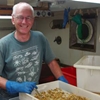General Description
Carapace with 2 mid-dorsal teeth including epigastric tooth and a longitudinal row of small teeth posterior to orbit. First leg subchelate (flat short claws ending in a finger fitting across an oblique palm); second legs much shorter than other legs. Third and fourth abdominal segments rounded dorsally. Mottled pale grey on top, like the sediments in which it lives, with white eyes, brilliant red posterior segments, three velvety black marks on the fifth abdominal somite, and sides and limbs purple, reddish or yellow. Up to 4.5 cm long.
Biology
Sand shrimps differ from all other caridean shrimps in having flat short chelipeds ending in a finger fitting across an oblique palm (rather than having two extended opposing fingers). This species was first reported in 1927 from Spencer Gulf, South Australia by Herbert Hale who described the colour as "exquisite", mottled pale grey on top, like the sediments in which it lives, with white eyes, brilliant red posterior somites, three velvety black marks on the fifth abdominal somite, and sides and limbs purple, reddish or yellow.
Habitat
Intertidal, to 10 m depth.
Soft substrates
Coastal shores
Distribution guide
Southern temperate oceans, including south-eastern Australia.
Species Group
Prawns, shrimps, lobsters › Shrimps
Depth
Shore (0-1 m)
Shallow (1-30 m)
Water Column
Max Size
4.5 cm
Diet
Organic matter
Commercial Species
No
Global Dispersal
Native to Australia
Conservation Status
- DSE Advisory List : Not listed
- EPBC Act 1999 : Not listed
- IUCN Red List : Not listed






